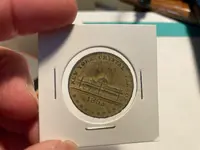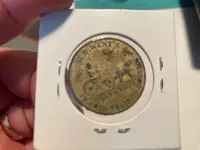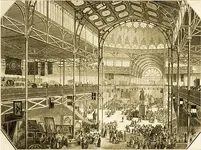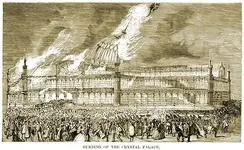That token is a great find 'H', it looks to be in incredible shape too.

The history behind these 19thc exhibitions is very interesting.
Dave
The H.B. West Token
Among the thousands of showmen and exhibitors who were featured at the Crystal Palace, the specimens below advertised H.B. West’s troupe of trained dogs named ‘Tray’ and ‘Troy.’ Clearly a promotional piece, it is undetermined whether these emissions actually served as tenderable tokens for the public. Like other tokens of the day, it is certainly plausible that the token was used as an admission check for an act or a show. The first specimen is catalogued as Miller NY-949. Struck in brass, and measuring 29mm in diameter, the specimen possesses a reeded-edge.
New York’s Crystal Palace
New York’s Crystal Palace was built in the early 1850s as an exhibition hall. Inspired by London’s famous Crystal Palace in Hyde Park, entrepreneur and promoter Christian E. Detmold had a dream to erect a similar venue in the United States, where industrialists, scientists, artists, and visionaries could publicly exhibit their works, inventions, and technological innovations.
Made from glass and steel, its main building was topped with an enormous dome and flagpole, and featured an gigantic open-space atrium within its main entranceway. Visible for blocks around, the Crystal Palace complex featured other buildings as well. Standing 315 feet tall, the Latting Observatory was built next to it. Taller than Trinity Church, for its time the tower was the highest man-made building in the New York City. Octagonal in shape and constructed of wood and iron, the tower featured an observation deck, where curious venue-goers could climb atop and gaze unobstructed at the city below, and its surrounding boroughs in the distance.
On October 5th 1858 without warning, the entire property became an inferno. Residents from all over New York City came to the palace, and stood by in astonishment, as the property conflagrated. Within hours the beautiful complex made of glass and steel had burned to the ground. At its final end, all that remained was a twisted skeleton of steel and ashes. A public inquiry was undertaken to determine the cause of the firestorm. Its source had been found to be a service shed loaded with spare lumber that had caught fire. However, given that the venue was constructed mainly of glass and steel, the inquiry found it quite implausible that the entire structure would burn so quickly and completely to the ground.
Although never fully substantiated, it was summarily assumed that the cause of the fire was arson, aided with the help of accelerants.









